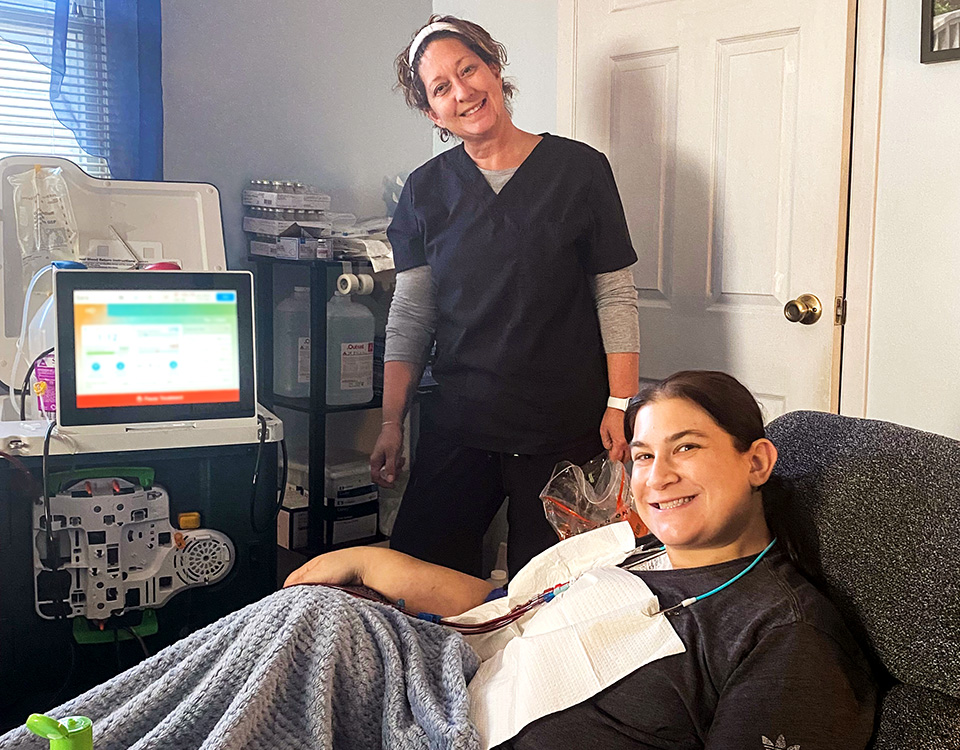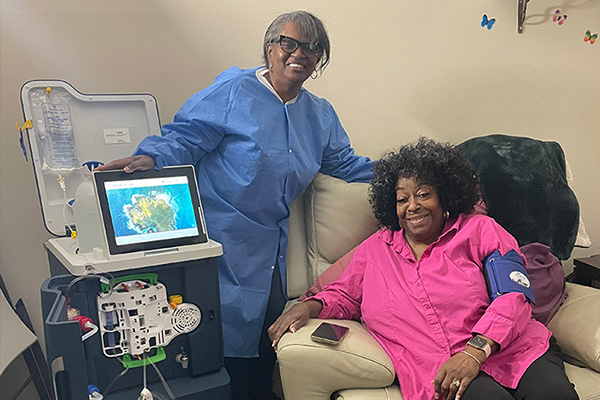From Hospital to Home Hemodialysis in Three Days: Sara’s Story

Summary
After crashing into dialysis in the ER, Sara opted to transition immediately to flexible home hemodialysis and a quality, normal life with her family.
Sara, her husband and seven-year-old daughter live in Massapequa, Long Island, NY. Her main concerns when discovering she was in kidney failure last year were to find a trustworthy nephrologist, and to live as normal a life as possible on dialysis. Fast-forward three months: done and done.
Now in her 40s, Sara had symptoms of kidney disease when she was a child. In seventh grade, she was anemic, and in her 20s she had protein in her urine and high blood pressure.
“Nobody was concerned at that point,” she said. “They checked my bloodwork and said my kidney function was normal. So, I went about my business.”
Sara gave birth to her daughter in 2015, after a normal pregnancy. About three years later, at age 35, she went for routine bloodwork and her creatinine was high. A kidney biopsy led to a diagnosis of focal segmental glomerulosclerosis (FSGS).
She was then referred to one nephrologist after another but became frustrated as she couldn’t find one who she trusted to help navigate her newly diagnosed kidney disease. “I never really felt like anyone was listening to my concerns,” she says. “I would get my bloodwork done, and every time they would say, ‘it’s worse now.’ My response was, ok, what are we doing then?”
She was overweight at the time, and felt like the doctors were blaming the kidney disease on that. “’If you would just lose weight, your problems would be fixed,’ they would say,” Sara says. “I weighed about 250 pounds. They even recommended gastric bypass surgery. No one talked about where I was headed with my kidney disease. Also, I was in denial as I was feeling fine.”
A Life-Changing Trip to the ER
Then, in October 2022, she started feeling very sick and had difficulty breathing. “I said to my husband, if I need dialysis, it’s got to be better than this,” Sara says. “I couldn’t even walk across my living room. I had to sleep while sitting up in a chair at night, I couldn’t lay down. I felt like I was drowning in myself.”
A nephrologist said her bloodwork showed that she was in stage 5 chronic kidney disease (CKD) and she needed to go to the emergency room immediately. He called ahead to the hospital ER to let them know she was coming, and it was there that Sara met her sixth, and current, nephrologist and care team.
On October 19, Sara had an emergency catheter placed and began hemodialysis in the hospital. She would spend the next 12 days having 50 pounds of fluid removed. Her new nephrologist, who she felt very comfortable with, presented her with all the options for her dialysis care going forward. He said that due to her condition there wasn’t time for peritoneal dialysis (PD), and if she did opt for PD at home once she was stabilized, it would need to be done every day for eight to nine hours. She could also choose to commute several days a week to a dialysis center for treatment. “I knew that I absolutely did not want to go to a center. I was very adamant,” she says.
Hospital to Home
Sara’s nephrologist then told her about another option: the easy to learn and use Tablo® Hemodialysis System. She and her husband, after a brief training period, would be able to manage Sara’s dialysis at home on their own schedule, needing only tap water and an electrical outlet. Tablo would give them the flexibility to fit her home dialysis around their family’s schedule. They had also looked at the one other hemodialysis system available for home use in the U.S. and selected Tablo due to its simplicity, compact size, user-friendly touchscreen with step-by-step animated guidance, wireless connectivity and ability to make dialysate on demand. “As someone with no healthcare background, it was very easy to figure out,” Sara says.
What’s more, her nephrologist mentioned a promising new program he had started to send select patients directly from the hospital to home on Tablo, thus avoiding treatment in a dialysis clinic. That’s all Sara needed to hear. After demoing a machine in her nephrologist’s office and seeing how easy it is to set up and use, Sara and her husband decided that Tablo was the best choice for them. “It’s the most flexible option. Since we have a younger daughter and we’re only in our 40s, we want to live as normally as we can,” she says.
“It’s the most flexible option. Since we have a younger daughter and we’re only in our 40s, we want to live as normally as we can.”
While Sara was still in the hospital, she was treated on a Tablo console and shown how it works. She was also taught to care for the chest catheter she would be using for her venous access while waiting for the arteriovenous (AV) fistula in her arm to mature. At the same time, her nephrologist prescribed a Tablo console to be delivered to their home, their home plumbing and electrical system were inspected and the minimal supplies delivered. Sara came home on October 29, and her first treatment was on November 1. She and her husband completed Tablo training over the next four weeks, with a nurse at their home for all treatments.
Sara typically treats in the evenings, four days a week for three and a half hours, after her daughter’s school day and her husband is home from work. After dinner, she starts treatment on her console set up in the bedroom, where she has a TV and a comfortable treatment chair. “We hang out together as a family during my treatment, it’s actually really nice,” she says.
Now after treating at home on Tablo for more than three months, Sara says that she and her family appreciate the ability to schedule her dialysis around their lives. She and her husband are able to participate in their board gaming group twice a month, and they enjoy time with their daughter.
Dialysis fits into my lifestyle instead of becoming my life.
“Most of the time I do my treatments on Monday, Tuesday, Thursday and Saturday,” she says. “It’s great because a few weeks ago we went and visited some friends in Jersey City on Saturday, and after checking with my nephrologist I did my treatment on Sunday instead. Dialysis fits into my lifestyle instead of becoming my life. I’m in control of my treatment, it doesn’t control me.”
“One of the main things that I’ve learned through this whole experience is that the fear of dialysis is worse than dialysis,” she continues. “Having kidney failure has been life changing, but I’m trying to focus on all the positives that have come from it. I’m more present for my family than I was before because I’m not so sick anymore. I feel like a normal human being.”
(Photo at the top of the page: Sara at home with her Tablo and nurse Randi Glasgow, RN, CDN.)

